A series looking at the high standard of morals of the Promised Messiahas, his Khulafa and the hospitality of the Ahmadiyya Muslim Community when receiving visitors
Ata-ul-Haye Nasir, Al Hakam
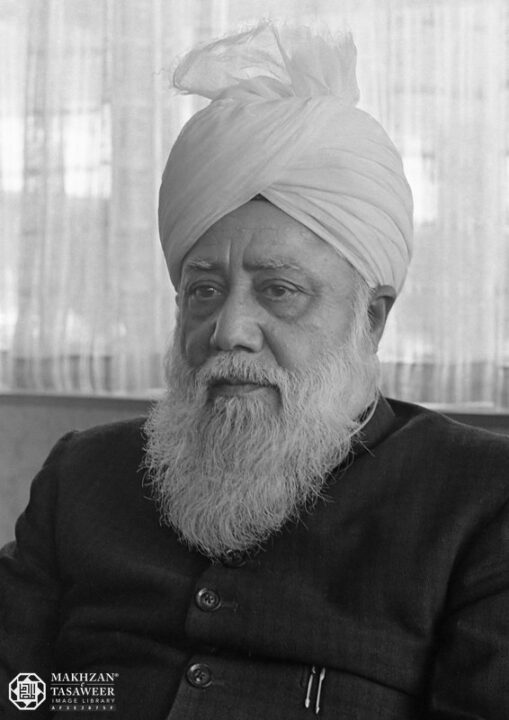
In 1967, The Ministry of USA, a periodical for the Ministerial Seventh-Day Adventists, published an article titled “Seventh-day Adventists and Ahmadiyat” by E Robert Reynolds, Academic Dean of the Pakistan Union School. In this article, he also mentioned an interview with Hazrat Hafiz Mirza Nasir Ahmad, Khalifatul Masih IIIrh.
It is worth acknowledging that the article might incorporate particular perspectives pertaining to the Promised Messiah’sas claims and Ahmadiyyat, which are based on the author’s own comprehension or convictions. Consequently, such interpretations should not be misconstrued as a comprehensive or accurate representation of the viewpoints or beliefs espoused by the Ahmadiyya Muslim Community.
Introduction to Dr E Robert Reynolds
Dr E Robert Reynolds, born in Lahore, British India, worked as a teacher, librarian, church pastor, and then the first Academic Dean for Pakistan Adventist Seminary (PAS). He also served the Pakistan Union of Seventh-Day Adventists in a number of capacities throughout Pakistan. While teaching at PAS, he completed his Master of Arts Degree in Islamic History at the Punjab University in Lahore, Pakistan. He was the first Christian to receive any advanced degrees in Islamic Studies at an all-Muslim university. On 22 October 1966, he was tragically shot while investigating a burglary at his family’s residence on the campus of PAS. About two weeks after being hospitalised in Lahore, his faculty advisor came to his room to inform him that his thesis had been accepted, and he was then called “Doctor”. His diploma was later received via the Pakistan consulate in Washington, DC. In his memory, a fund was also established, known as “E. Robert Reynolds Jr. Student Loan Fund.” (“E. Robert Reynolds Jr. Student Loan Fund”, www.gemresources.org)
At the beginning of this article, we find an editorial note as well, which states:
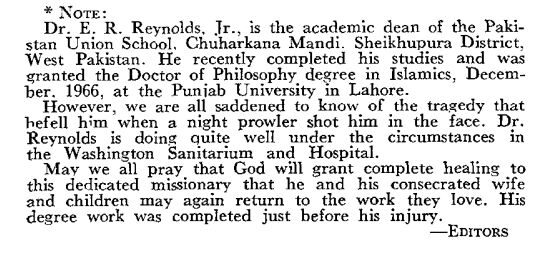
“Dr. E.R. Reynolds, Jr., is the academic dean of the Pakistan Union School, Chuharkana Mandi, Sheikhupura District, West Pakistan. He recently completed his studies and was granted the Doctor of Philosophy degree in Islamics, December 1966, at the Punjab University in Lahore. However, we are all saddened to know of the tragedy that befell him when a night prowler shot him in the face. Dr. Reynolds is doing quite well under the circumstances in the Washington Sanitarium and Hospital. May we all pray that God will grant complete healing to this dedicated missionary that he and his consecrated wife and children may again return to the work they love. His degree work was completed just before his injury.”
The article
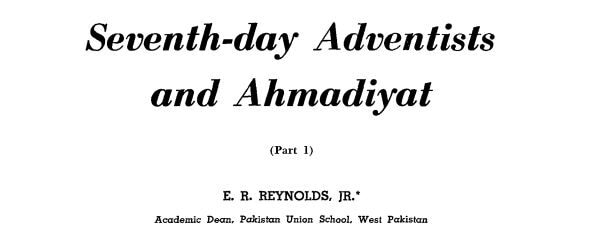
In his article, Mr Reynolds wrote:
“Many of the readers of this journal will find the word Ahmadiyat a new one to them […]. Spelled variously as Ahmadiyat, Ahmadiyyat, or Ahmediyyat, the term signifies the religious movement founded in the late nineteenth century by Mirza Ghulam Ahmad[as] of Qadian, in Northern India. Its world headquarters today is at Rabwah, in West Pakistan. It was intended to be a revivalist movement within Islam, not only to call Moslems back to what Mirza Ghulam Ahmad[as] considered was pristine Islam but also to challenge both Christianity and Hinduism to defend their positions, or more appropriately, to leave their apostate religions in exchange for what the Ahmadi founder believed to be the ‘true’ Islam.
“The size of this sect is as numerically insignificant among the hundreds of millions of Moslems as are Seventh-day Adventists among the hundreds of millions of Christians. But quantity is not always the sole determining factor as to what constitutes significance.
“The interest of Seventh-day Adventists in this sect ought to lie in two major areas. The first of these is theological, embracing either points of faith that have marked similarities or are prominent features of beliefs that are diametrically opposed. […]
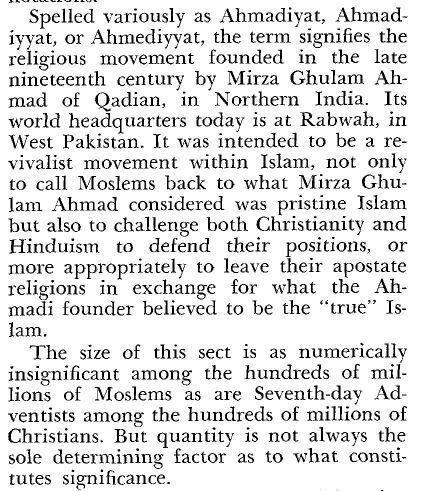
Needs Entire Book
“This article cannot begin to treat adequately the first interest. It needs an entire book. Outside of brief encyclopedia articles, there is very little recent scholarly work on Ahmadiyat. Professor Smith of McGill University’s Institute of Islamic Studies suggests that the last scholarly work was Lucien Bouvat’s article in the Journal Asiatique in 1928 [titled “Les Ahmadiyya De Qadian”, Jul-Sep 1928, Vol. CCXIII, pp. 159-181]. Smith himself has written in the New Encyclopaedia of Islam, and touched on them from a social point of view in some of his books. Dr. Kenneth Cragg, in his book The Call of the Minaret, discusses them somewhat also. But theologically speaking, there is nothing in print that takes up their work in a systematic and detailed academic manner.
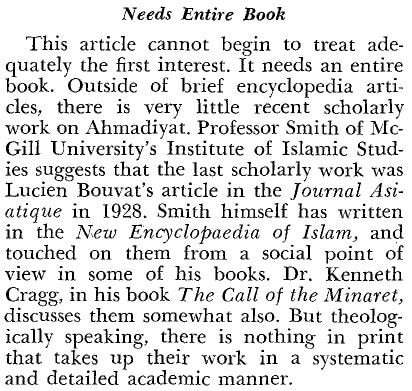
“My interest in Ahmadiyat first began because of a friendship I formed with an Ahmadi printer who was kind enough to help me translate some evangelistic advertising fifteen years ago when I first came to Pakistan. I did not know the language well, and the Pakistani worker helping me did not know English any better. This Ahmadi was well enough versed in Christian ideas to help me with words that had the right nuance.
“Later, during graduate study at the University of the Punjab, I had occasion to broaden my academic knowledge of Ahmadiyat, and to study the life and work of the Founder in considerable detail. This has resulted further in some fine friendships and contacts with these very sincere people.
“Arising out of this study, it was my privilege recently to spend some time in interviewing the present head of the movement, Mirza Nasir Ahmad[rh], Khalifat-ul-Masih III, who is the grandson of the Founder [Hazrat Mirza Ghulam Ahmad[as] of Qadian], and who was elected to his present position by the community upon the death of his father [Hazrat Mirza Bashir-ud-Din Mahmud Ahmadra, Khalifatul Masih II] in November of 1965.
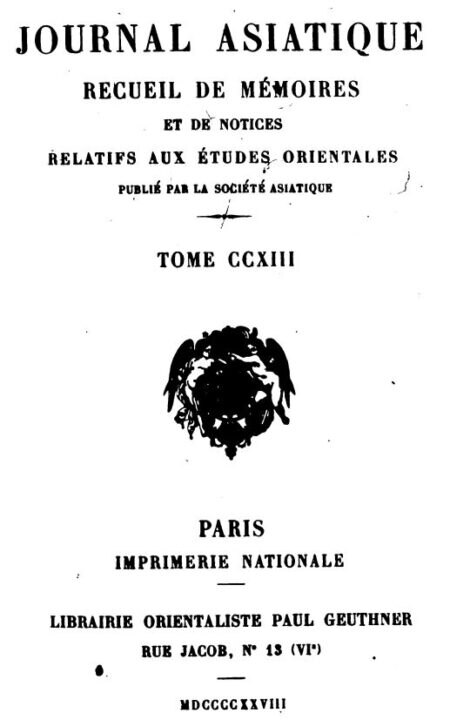
Embarrassing Methods
“No one working in the larger centers of Moslem population can long avoid meeting the Ahmadi missionaries. Wherever a Christian evangelist begins a work of public missionary effort, one of these persistent emissaries of Ahmadiyat is sure soon to show up. His presence can be embarrassing if the evangelist is unacquainted with the methods of the Ahmadis.
“Appearing to be the spokesman for the Moslems present, the Ahmadi ‘evangelist’ will do his best to pose logical dilemmas that the tactful Christian would rather meet in private, and his attempt to sidestep the interruption in a public confrontation is turned frequently to mean an inability to answer the questions posed, and is meant to imply thereby the spiritual inferiority of Christianity. […]
“The great advances of Islam in certain areas of earth today, as opposed to the spread of Christianity, are for the most part the work of Ahmadiyat, or stimulated by Ahmadis. It is with this aspect of Ahmadiyat that I would be principally concerned herein. On the occasion of my interview with Mirza Nasir Ahmad[rh], I went first to the Foreign Missions office where I was introduced to Mr. Naseem Saifi, who was to be my guide for the day. Mr. Saifi had just returned from twenty years of missionary service in Nigeria and other parts of West Africa.
Billy Graham Challenged
“It was Mr. Saifi who in 1960 first challenged Dr. Billy Graham to a debate in Lagos, Nigeria, during the latter’s African safari for Christ. It was also an Ahmadi missionary, Sheikh Mubarik Ahmad, who challenged the evangelist in East Africa to a prayer duel. While the Christian world’s presses and newspapers took note of the incidents, reporting how Dr. Graham had handled the two situations without becoming embroiled in controversy, the Ahmadis published widely the triumph for Islam his failure to meet them openly seemed to them to imply.
“With respect to Mr. Saifi, I would like to add that, having read the press reports of Dr. Graham’s contacts with him, I expected to meet a firebrand. Instead, I found him to be a quiet, assured gentleman. It was a pleasure to make his acquaintance.
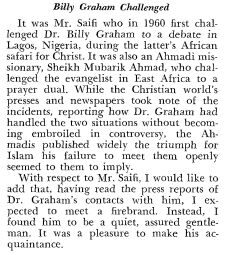
Educational and Publishing System
“[…] They have their own educational system and give a good education. Many of their members are widely respected for their learning and abilities. Perhaps the most outstanding example of this is Chaudry Sir Zafrulla Khan[ra], currently on the bench of the World Court. Having been a past president of the United Nations General Assembly, he is an Ahmadi of international repute, and is also the author of a number of religious works designed to share his faith.
“The Ahmadi publishing houses turn out literature for their cause in more volume than those of most religious organizations of the present time. Their philanthropy and care for the widow and orphan should also be noted. While they have not approached a Seventh-day Adventist level of medical missions, many an Ahmadi physician is a medical missionary on his own.
“When I was ushered into the parlor of the Khalifa’s home for my appointment, I was met most courteously by the distinguished leader. A kind, quiet-spoken gentleman in his late fifties, the Mirza Sahib[rh] is a graduate of Oxford University, and a former college principal. We talked of their organizational structure, which has many parallels to that of Seventh-day Adventists. We also discussed the future of their mission program. Their greatest successes are in West Africa, with East Africa and Indonesia following.
“Mirza Nasir Ahmad[rh] stated that the progress of Ahmadiyat today is as rapid in Tanzania as in West Africa. The size of the group, however, has not yet reached that of West Africa, where the largest group is in Ghana. The converts in Ghana come largely from paganism. In Sierra Leone, however, Mirza Nasir Ahmad[rh] told me, they are converting to Ahmadiyat more members from the Christian community than from other groups. In Nigeria, on the other hand, the growth of Ahmadiyat is largely taking place within the Moslem community, he reported. […] In Indonesia, it is largely from among the Moslems that they are recording their greatest successes. […]
“From a theological viewpoint, the Ahmadis have some parallels of interest to Seventh-day Adventists. The only one I can touch on here is their belief in a continuing revelation from God. This provides a source of contact that immediately catches their interest and attention.
“Orthoprax Moslems — that is, those who hold conservatively to the practices of the Moslem faith, as orthodoxy signifies conservative theology — believe that Mohammed[sa] was the last of the prophets, and that all that previous prophets had given is succinctly wrapped up in the Koran. For them, therefore, there is no further need for any of the earlier revelations today. The apostate interpretations of the Bible, together with the purported physical corruptions of the Biblical text, make those earlier messages from God invalid today.
“While Ahmadis believe likewise about the Bible, and use many of the skeptical arguments of the nineteenth century in support of their position, as well as finding anything in current literature, they do not believe that Mohammed[sa] was the last of the prophets in the same way that others do. […] Because of this, most Moslems put the Ahmadis outside the pale of Islam, even though the group claims it is the only true advocate of a genuine Islam.
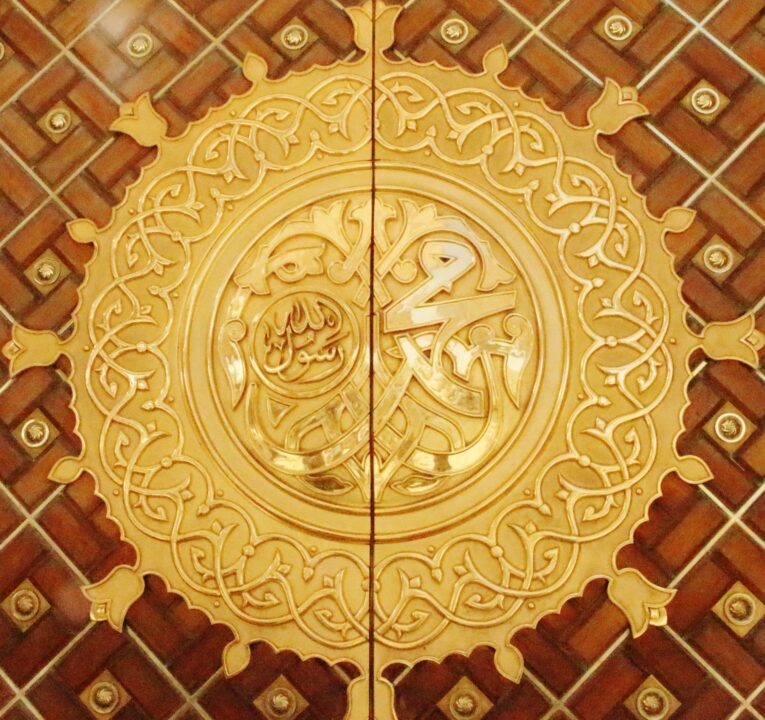
Gift of Prophecy
“For the Ahmadis, Mohammed[sa] is the criterion of truth, and all future prophets must acknowledge his message as truth in the way that he taught it, and not in the way it has come to be corrupted by the Moslems. In order to restore it to its rightful place, God has been pleased, they say, to speak in modern times to and through Mirza Ghulam Ahmad[as]. […] Therefore it has been necessary for a renewal of revelation to be given in this century. […]
“If the Ahmadis are approached in a gentle manner, in the modern spirit of dialog rather than in the harsher forms of debate, they will listen, at least for a time. I do not mean they will be converted. I do not know of any Ahmadi in India or Pakistan that has become a Seventh-Day Adventist. But I am sure that God has a message for these earnest people, as well as for others. They have some very high and noble ideals. […]
“In closing my interview with Mirza Nasir Ahmad[rh], I asked the Khalifa of the Community a question which is closely linked with special revelation, and more particularly with that of Mirza Ghulam Ahmad[as]. It had to do with spiritistic phenomena.
“The Ahmadis are strong believers in the doctrine of natural immortality, a doctrine that should concern every Seventh-Day Adventist. I knew that Mirza Ghulam Ahmad[as] claimed to have talked with various departed dead, including Guru Nanak Sahib[rh] (the fifteenth-century founder of the Sikh religion of Northern India) and Jesus[as] Christ!
Jesus[as] Buried in Kashmir!
“According to all Ahmadis, Jesus[as] Christ is dead, buried in Kashmir. They will show you ‘his’ tomb there to prove it. I have seen it. Unlike all other Moslems, they hold that Jesus[as] was put on the cross, but did not die then. Taken down alive, he made his escape from Palestine, and lived to die a natural death at a ripe old age of 120 years in Kashmir. […] Other Moslems believe that Jesus[as] is alive in heaven. But not the Ahmadis.
“Accordingly, the promises in both the Bible and the Koran [sic., Quran] regarding the return of the Messiah would be impossible of literal fulfillment. Mirza Ghulam Ahmad[as] claimed, on the ground of his special revelations, to be the Messiah of Islam, and the fulfillment of those prophecies. He never claimed, as some of his enemies have tried to make out, that he was the reincarnation of Jesus[as]. But he did claim to be the Messiah in unequivocal language. It was here that he first parted serious company with his Moslem peers. To me, the tragedy of Ahmadiyat is that their faith rests upon the death of two Messiahs, the second one having been the fulfillment of previous prophecies, leaving no more Messiahs to come! […]
“As such, there are many genuine elements of truth to be found in Ahmadiyat. These will appeal to the human heart in search after God. [….] Because of these factors, it seems to me that the Seventh-Day Adventist who attempts to debate with the Ahmadis is in danger of repeating for himself the experience of Moses Hull in the early days of the Advent Movement. Adventists must, therefore, approach them with caution, and in humble dependence upon God for power personally to persuade them of the verities of the message God has vouchsafed to the church for the world at this time.” (The Ministry, March and April 1967)

